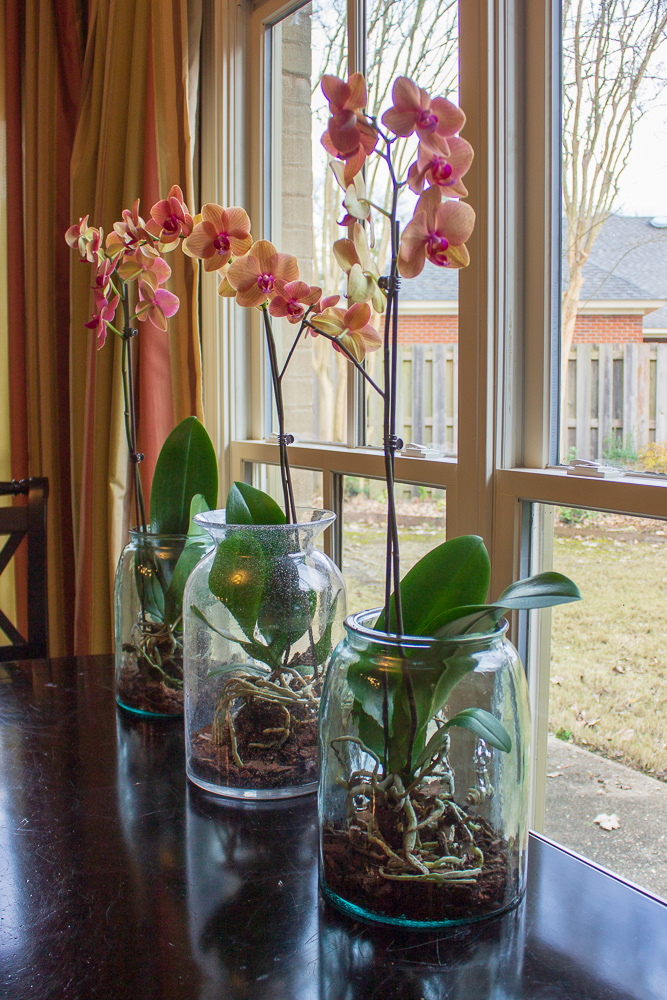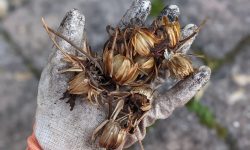Yes, orchids can be grown in glass jars as long as the jar is big enough and has drainage holes. The reason why some people choose to grow their orchids in glass jars is because it’s a way to create a mini-greenhouse for the plant. By doing this, you can control the environment that your orchid is growing in which means you can give it the ideal conditions it needs to thrive.
If you’re looking for a unique and beautiful way to display your orchids, glass jars are a great option! Orchids can absolutely be grown in glass jars, as long as a few key factors are met. First, it’s important to make sure that the jar has good drainage.
Without proper drainage, your orchid’s roots will rot and the plant will quickly die. Second, be sure to use an appropriate potting mix for your orchid. A general rule of thumb is to use a mix that is light and airy, such as sphagnum moss or perlite.
Third, it’s crucial to provide plenty of ventilation for your orchid by drilling small holes in the lid of the jar. And finally, be sure to give your orchid plenty of bright indirect light – too much direct sun will scorch the leaves.
With these guidelines in mind, growing an orchid in a glass jar can make for a stunning and low-maintenance display!

Credit: www.misskopykat.com
Can You Put a Orchid in a Glass Jar?
Yes you can put an orchid in a glass jar, but there are some things to keep in mind. Orchids need bright, indirect sunlight and good air circulation to thrive. If you’re using a clear glass jar, make sure to place it in a spot where it will get plenty of light.
You’ll also want to provide some sort of support for the plant so it doesn’t topple over. A small piece of moss or even a coffee filter placed at the bottom of the jar can work well. Be sure to water your orchid regularly, letting the roots soak up water for about 15 minutes and then draining any excess.
Over time, you may need to repot your orchid into a larger container as it grows.
Can You Plant Orchids in Glass?
If you’re looking to add a touch of elegance to your home, you can’t go wrong with an orchid. These beautiful flowers come in a wide variety of colors and sizes, and they’re relatively easy to care for. But what if you don’t have a green thumb?
Can you still enjoy the beauty of an orchid without killing it?
The good news is that yes, you can plant orchids in glass. The even better news is that it’s actually pretty easy to do.
Here’s what you need to know:
First, choose the right type of orchid. There are many different varieties of orchids, and not all of them will do well in glass.
You’ll want to choose an Orchidaceae species, like Phalaenopsis or Paphiopedilum, which are both commonly known as moth orchids. These types of orchids are epiphytic, which means they grow on other plants but don’t require soil to thrive.
Next, pick out the right size pot.
Your pot should be only slightly larger than the root ball of your plant. If the pot is too large, your orchid will be susceptible to rot; too small and it will dry out quickly. A clear glass pot is ideal so that you can easily check on the roots and monitor watering needs.
Be sure to use pots with drainage holes so that excess water can escape and roots don’t sit in soggy conditions.
Now it’s time to prepare your potting mix. Orchids need a light and airy growing medium that drains well but still holds some moisture.
You can either purchase a commercial Orchid Mix at your local nursery or make your own by mixing together sphagnum moss, perlite, charcoal, and pine bark chips (in equal parts). Once you’ve got your mix ready, moisten it lightly before adding it to your pot – just enough so that it’s damp but not wet. Gently break up any clumps as you add it into the pot until it’s about two-thirds full; then tamp down gently with your fingers before adding more mix until the pot is three-quarters full (leaving room for watering). Now carefully transfer your orchid into its new home – being careful not to damage any roots – and fill in around the root ball with more mix until everything is level with the top edge of the potting mixture (again leaving room for watering). Water thoroughly until water runs out through the drainage holes; then allow the plant to drain completely before putting it back in its spot (preferably near an east-facing window).
How Do You Take Care of an Orchid in a Glass Cylinder?
Assuming you would like tips on how to take care of an orchid in a glass cylinder:
When it comes to taking care of an orchid, there are a few key things to remember. First and foremost, be sure to choose the right type of potting mix.
Orchids need a light and airy potting mix that will help with drainage. Be sure not to use regular potting soil as this can cause your orchid to become overwatered.
Next, water your orchid regularly but be sure not to overwater it.
The best way to water an orchid is by using the mist setting on your kitchen sink sprayer. Allow the water to run through the plant until it begins dripping out of the bottom of the pot. Once this happens, stop watering and allow the plant to drain before putting it back in its spot.
In terms of sunlight, orchids do best in bright indirect sunlight. This means placing them near a window where they will get plenty of light without being in direct sun which can scorch their leaves.
Finally, be sure to fertilize your orchid every other week using a balanced fertilizer diluted by half.
Apply the fertilizer directly after watering for best results.
What Kind of Container is Best for Orchids?
When it comes to orchids, the type of container you use is important. The wrong type of container can cause problems with drainage, aeration, and even root rot. So what kind of container is best for orchids?
The answer may surprise you: plastic! That’s right, plastic containers are actually the best choice for orchids. They’re lightweight, durable, and inexpensive.
Plus, they provide good drainage and aeration. Just be sure to choose a container with holes in the bottom for drainage.
So if you’re looking for the best type of container for your orchids, go with plastic.
It’s the perfect material to help your plants thrive.
Orchids in Glass
Orchids in Glass Jars
Orchids in Glass Jars
If you’re looking for a unique and beautiful way to display your orchids, look no further than glass jars! Orchids in glass jars make for a stunning focal point in any room, and they’re surprisingly easy to care for.
Here’s everything you need to know about growing orchids in glass jars.
The first thing you’ll need is a glass jar of your choice – anything from a mason jar to a fishbowl will work. Make sure the jar has drainage holes drilled into the bottom, and fill it with a layer of gravel or rocks.
This will help keep your orchid’s roots healthy by providing good drainage. Next, add some potting mix designed specifically for orchids – don’t use regular potting soil, as it won’t provide the right nutrients for your plant. Water your orchid well, then place it gently into the jar on top of the gravel/rocks.
Add more potting mix around the roots if necessary.
Now that your orchid is all set up, it’s time to give it the proper care it needs to thrive. First and foremost, make sure your plant gets plenty of bright indirect sunlight – an east-facing window is ideal.
Orchids like their soil to be moist but not soggy, so water when the top inch of soil feels dry (usually once per week). Be careful not to overwater – too much moisture can lead to root rot. In addition, fertilize every other week using a balanced fertilizer formulated specifically for orchids (following package directions).
With proper care, your gorgeous glass-jarred orchid should bloom year-round!
Phalaenopsis Orchid in Glass Vase
If you’re looking for a low-maintenance plant that will add a touch of elegance to any room, look no further than the Phalaenopsis Orchid. These beautiful flowers are native to Southeast Asia and thrive in humid environments. While they can be finicky about their watering and light requirements, once you get them settled into a routine they are relatively easy to care for.
One of the best ways to display a Phalaenopsis Orchid is in a glass vase. This allows you to see the roots of the plant, which are an important part of its overall health. The roots should be white and healthy looking – if they start to turn brown or mushy, it’s time to give your Orchid a drink!
Water your Orchid once per week, making sure that the water drains out completely each time. Overwatering is one of the quickest ways to kill an Orchid, so it’s important not to let it sit in stagnant water.
In addition to regular watering, your Orchid will also need bright indirect sunlight.
A south-facing window is ideal, but east or west facing windows will also work well. Avoid placing your Orchid in direct sunlight, as this can scorch the leaves and damage the flowers. If you don’t have access to natural light, you can supplement with artificial grow lights – just make sure they are placed about 12 inches away from the plant so that it doesn’t get too much heat exposure.
With proper care, your Phalaenopsis Orchid should bloom multiple times per year. Enjoy your beautiful blooms!
Real Orchid in Tall Glass Vase
If you’re looking for a stylish, yet simple way to spruce up your home décor, consider adding a real orchid in a tall glass vase. Not only are they beautiful and elegant, but they’re also easy to care for. Here’s what you need to know about caring for your real orchid:
Light – Orchids prefer bright, indirect light. Too much direct sunlight can scorch the leaves, so be sure to place your orchid in a spot where it will receive plenty of light without being in direct sun.
Water – Water your orchid once a week, making sure that the roots are thoroughly soaked.
Allow the excess water to drain away and then empty the drip tray beneath the pot. Be careful not to over-water as this can lead to root rot.
Fertilizer – Use a low-nitrogen fertilizer formulated specifically for orchids every other week during the growing season (spring through fall).
During the winter months, you can reduce fertilizing to once a month.
Temperature & Humidity – Orchids thrive in warm temperatures (70-85 degrees Fahrenheit) with high humidity (60-80%). If your home is on the drier side, consider placing your orchid on a pebble tray filled with water (make sure the pot is sitting on top of the pebbles and not in the water) or using an electric humidifier nearby.
Large Glass Bowl for Orchids
An orchid is a beautiful, delicate flower that can be difficult to grow. One of the most important things you can do to ensure your orchid blooms is to provide it with the proper environment. This means creating an artificial atmosphere that has the correct humidity, temperature, and light for your specific type of orchid.
One way to create the ideal environment for your orchid is to use a large glass bowl. By placing your plant in a bowl, you can more easily control the humidity around it. The glass will also help to hold in heat and moisture, creating a microclimate perfect for your orchid.
Be sure to choose a bowl that is big enough for your plant and has plenty of drainage holes so that it does not become waterlogged.
In addition to using a large glass bowl, there are several other things you can do to care for your orchid and encourage it to bloom. Watering regularly and fertilizing according to manufacturer’s directions are both important.
You should also repot your orchid every one to two years using fresh potting mix specifically designed for orchids. With proper care, you can enjoy watching your orchid bloom year after year!
Conclusion
If you’re looking for a fun and unique way to grow your orchids, why not try growing them in glass jars? While it may seem like an unconventional way to grow these beautiful flowers, it can actually be quite easy and rewarding. Here are a few tips on how to successfully grow orchids in glass jars:
1. Choose the right type of jar. Orchids need plenty of airflow, so avoid using sealed jars or ones with small openings. Instead, opt for wide-mouth jars that will allow your plants to breathe.
2. Make sure the jar is clean. Before adding your orchid plant, give the jar a good cleaning with soap and water. This will help ensure that your plant stays healthy.
3. Add drainage holes to the bottom of the jar. To prevent your orchid from sitting in water, drill a few small holes in the bottom of the jar before adding soil. This will allow excess water to drain out quickly.
4. Use quality potting mix . When choosing a potting mix for your orchid, make sure it’s well-draining and contains plenty of organic matter such as bark chips or perlite . Regular potting soil won’t work well since it tends to retain too much moisture which can lead to problems for your plant.
5., Be careful not to overwater . One of the biggest mistakes people make when growing orchids is overwatering them . These plants don’t require a lot of water so be sure to only water them when the soil is dry .
If you’re unsure , stick your finger into the soil about an inch deep – if it feels moist then you don’t need to water yet .






